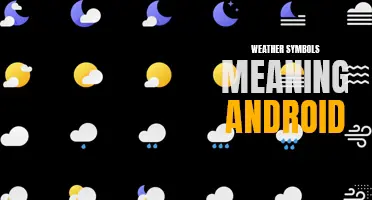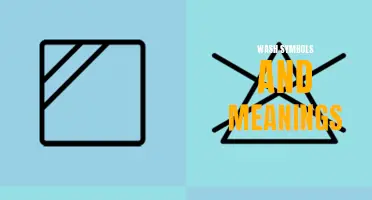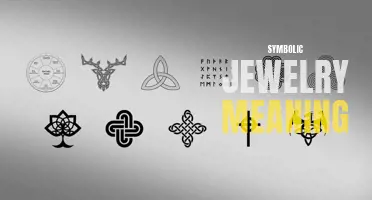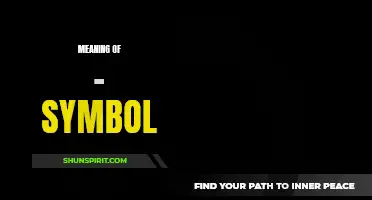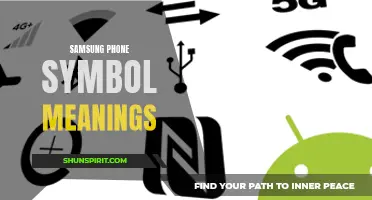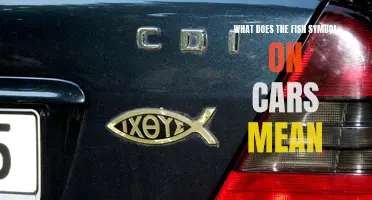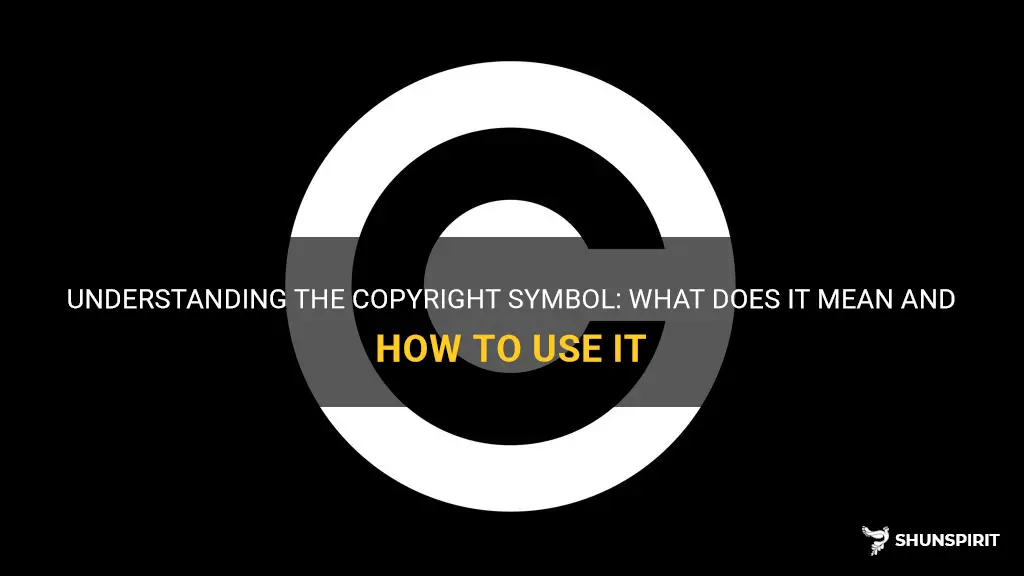
Copyright symbol, also known as the copyright sign or the circled C, is a small yet powerful pictographic representation of intellectual property protection. This symbol, universally recognized, signifies ownership and exclusive rights to creative works, be it literature, music, art, or any other form of expression. With its simple yet impactful design, the copyright symbol serves as a constant reminder of the importance of protecting original ideas and ensuring the rightful attribution and compensation for creators. As an emblem of originality and ownership, the copyright symbol plays a crucial role in the world of intellectual property law and serves as a beacon of creativity, encouraging innovation and artistic expression.
What You'll Learn
- What is the purpose of the copyright symbol?
- How does the copyright symbol protect intellectual property?
- What is the meaning of the copyright symbol in different countries?
- Can I use the copyright symbol without registering my work?
- Are there any alternative symbols or methods to indicate copyright protection?

What is the purpose of the copyright symbol?
The purpose of the copyright symbol is to indicate that a work is protected by copyright and that the owner or creator of the work has exclusive rights to that work. When a work is copyrighted, it means that the owner has the right to control how the work is used, reproduced, distributed, displayed, and performed. The copyright symbol serves as a notice to others that the work is protected and that they should seek permission from the owner before using or reproducing the work in any way.
The use of the copyright symbol is not a requirement for copyright protection, as copyright is automatically granted to the creator of a work as soon as it is fixed in a tangible form. However, using the copyright symbol provides additional legal protection and makes it easier for the owner to prove that they have a valid copyright in case of infringement.
The copyright symbol consists of the letter "c" inside a circle (©) and is usually placed next to the name of the copyright owner and the year of first publication. This symbol can be used for both published and unpublished works. In addition to the copyright symbol, it is common to include the word "copyright" or its abbreviation "copr." before the copyright symbol, along with the name of the copyright owner and the year of first publication.
By placing the copyright symbol on their work, creators are notifying others that they have the exclusive rights to their work and that unauthorized use or reproduction of the work may result in legal consequences. It is a way for creators to assert their intellectual property rights and protect their creations from being used or copied without permission.
In conclusion, the purpose of the copyright symbol is to provide notice that a work is protected by copyright and that the owner has exclusive rights to that work. It serves as a deterrent against unauthorized use or reproduction of the work and helps the owner establish their legal rights in case of infringement. While the use of the copyright symbol is not required for copyright protection, it is highly recommended for creators who want to safeguard their intellectual property.
Understanding the Kosher Symbols and Their Meanings
You may want to see also

How does the copyright symbol protect intellectual property?
Intellectual property is defined as creations of the mind, such as inventions, literary and artistic works, designs, symbols, and names used in commerce. These intangible assets play a crucial role in the global economy and are protected under the law to encourage innovation and creativity. One of the primary ways to protect intellectual property is by using the copyright symbol.
The copyright symbol, denoted by the © sign, is a legal symbol that denotes ownership and protection of an original work of authorship. When an individual or an organization creates an original work, such as a book, music, artwork, or software, they automatically gain the copyright to that work. However, applying the copyright symbol signifies that the creator is asserting their rights and preventing others from using, copying, distributing, or adapting their work without permission.
By using the copyright symbol, creators establish a legal presumption that they hold the rights to the work. This makes it easier to protect their intellectual property in court and seek damages if their work is copied or used without authorization. It also serves as a deterrent to potential infringers who may be less likely to plagiarize or exploit the work if they know it is protected by copyright.
To officially obtain copyright protection, creators can register their work with the appropriate intellectual property office in their country. While copyright protection is automatic, registration provides additional benefits. For instance, in the United States, registering a work grants the creator the right to sue for statutory damages and legal fees in the case of infringement.
The copyright symbol is not the only way to protect intellectual property. Other forms of intellectual property protection include patents for inventions, trademarks for brands and logos, and trade secrets for confidential business information. Each form of protection is tailored to the specific type of intellectual property and provides different rights and benefits.
However, the copyright symbol remains one of the most crucial tools for protecting intellectual property in creative industries. It alerts others that the work is protected and should not be used without permission, thereby encouraging respect for the rights of creators and fostering a culture of innovation and creativity.
In conclusion, the copyright symbol plays a vital role in protecting intellectual property. It asserts ownership and safeguards original works from unauthorized use or exploitation. By using the copyright symbol, creators can establish their rights, seek legal protection, and ensure that their intellectual property is respected and valued in the marketplace.
The Meaning Behind the Triangle Symbol in Chemistry: Decoding its Significance
You may want to see also

What is the meaning of the copyright symbol in different countries?
The copyright symbol © is used to signify the protection of intellectual property rights, specifically for literary, artistic, and creative works. While it is a universally recognized symbol, the meaning and legal implications of the copyright symbol vary depending on the country.
In the United States, the copyright symbol is often used to indicate that a work is protected under copyright law. It serves as a notice to the public that the work is copyrighted and that the author or creator has exclusive rights to control its reproduction, distribution, and public display. The symbol is not required for copyright protection in the United States, as copyright is automatic upon the creation of a work. However, using the symbol can help deter copyright infringement and strengthen the copyright holder's legal position in case of a dispute.
In many other countries, including the United Kingdom and Canada, the use of the copyright symbol is not mandatory. The copyright laws in these countries automatically grant copyright protection to original works upon creation, similar to the United States. However, unlike the United States, the copyright symbol is not commonly used in these countries as a means of providing notice of copyright protection.
In some jurisdictions, such as Australia and New Zealand, the use of the copyright symbol is optional but can be beneficial. It can act as a visual reminder that the work is protected and can help discourage unauthorized use.
It is important to note that while the copyright symbol may not be required in certain countries, copyright protection still exists and is enforceable. In most countries, including those that do not require the use of the symbol, the mere act of creating an original work automatically grants the creator copyright protection.
In conclusion, the meaning and legal implications of the copyright symbol vary depending on the country. In the United States, the symbol is often used to provide notice of copyright protection, while in other countries it is not mandatory. Regardless of the use of the copyright symbol, copyright protection exists automatically upon the creation of an original work in most jurisdictions.
Unlocking the Symbolic World of Pandas: Discovering the Meaning Behind their Endearing Image
You may want to see also

Can I use the copyright symbol without registering my work?
The copyright symbol, also known as the copyright sign ©, is used to indicate that a work is protected by copyright. While it is not necessary to register your work with a copyright office to use the copyright symbol, there are benefits to registering your work.
The use of the copyright symbol serves as a notice to the public that the work is protected by copyright. It puts others on notice that they may need permission from the copyright owner to use or reproduce the work. This can deter potential infringers and help protect your rights as the creator of the work.
However, it is important to note that while using the copyright symbol can provide some level of protection, it does not provide the same legal protections as copyright registration. Copyright registration is the formal process of submitting your work to a copyright office to obtain a copyright certificate.
Registering your work with a copyright office has several advantages over simply using the copyright symbol. First, it establishes a public record of your copyright ownership. This can be helpful in the event of a dispute or if you need to enforce your rights. Additionally, registering your work before infringement occurs or within a certain timeframe after publication allows you to seek statutory damages and attorney's fees in a copyright infringement lawsuit. This can provide a stronger legal position and potentially increase the damages you can recover.
In the United States, for example, copyright registration with the U.S. Copyright Office is not required for works to be eligible for copyright protection. However, it is generally recommended, especially if you plan to enforce your rights or seek damages in the event of infringement.
To register your work, you would need to complete an application, pay a filing fee, and submit a copy of the work being registered. The requirements and processes for copyright registration may vary depending on your country, so it is advisable to consult the copyright office or consult with a copyright attorney to ensure you are following the correct procedures.
In conclusion, while it is not necessary to register your work with a copyright office to use the copyright symbol, registering your work provides additional legal protections and advantages. If you want to enhance the protection of your work and have the ability to seek statutory damages, it is advisable to consider copyright registration.
The Hidden Symbolism Behind the Hamsa Hand: Unveiling Its True Meaning
You may want to see also

Are there any alternative symbols or methods to indicate copyright protection?
When it comes to copyright protection, the first symbol that comes to mind is the copyright symbol, ©. It is a universally recognized symbol used to indicate that a work is protected by copyright. However, there are alternative symbols and methods that can be used to indicate copyright protection.
One alternative symbol is the "C" in a circle, also known as the circled C. This symbol is commonly used in place of the copyright symbol when the copyright symbol cannot be easily reproduced, such as in plain text or on certain digital platforms. The circled C can be typed as (C) or ©, or represented by the Unicode character U+24C5.
Another alternative symbol is the "P" in a circle, also known as the sound recording copyright symbol. This symbol is used specifically to indicate copyright protection for sound recordings. It is commonly used in the music industry to signify that a sound recording is protected by copyright. The sound recording copyright symbol can be typed as (P), or represented by the Unicode character U+2117.
In addition to alternative symbols, there are also alternative methods to indicate copyright protection. One method is the use of the word "Copyright" or the abbreviation "Copr." followed by the year of first publication and the name of the copyright owner. For example, "Copyright 2022 John Doe" or "Copr. 2022 Jane Smith." This method is commonly used in situations where the use of a symbol may not be practical or necessary.
Another method is the use of the phrase "All rights reserved." This phrase is often used to indicate that the copyright owner reserves all rights in the work and that unauthorized use of the work is prohibited. It can be used in conjunction with a symbol or on its own. For example, "© 2022 John Doe. All rights reserved." or "All rights reserved. © 2022 Jane Smith."
It is important to note that while the use of symbols or methods to indicate copyright protection is common and recommended, it is not a legal requirement. Copyright protection exists automatically from the moment a work is created and fixed in a tangible form. However, the use of symbols or methods can help to provide notice to others that the work is protected by copyright and deter infringement.
In conclusion, while the copyright symbol, ©, is the most commonly recognized symbol used to indicate copyright protection, there are alternative symbols and methods that can be used. These alternative symbols include the circled C and the sound recording copyright symbol, while alternative methods include using the word "Copyright" or "Copr." followed by the year and the copyright owner's name, or the phrase "All rights reserved." Ultimately, the choice of symbol or method to indicate copyright protection is up to the copyright owner, and the important thing is to provide notice to others that the work is protected by copyright.
Exploring the Symbolic Depths: Unraveling the Meaning of the Tree of Life Symbol
You may want to see also
Frequently asked questions
The copyright symbol (©) is used to indicate that a work is protected by copyright and that the creator or owner of the work has exclusive rights to reproduce, distribute, and display the work. It serves as a notice to others that the work is protected and that permission must be obtained before using it.
Yes, you can use the copyright symbol even if you haven't registered your work. Copyright protection is automatic as soon as your original work is created and fixed in a tangible form. However, registering your work with the Copyright Office provides additional legal benefits.
Technically, you can use the copyright symbol on everything you create, as long as it meets the criteria for copyright protection. However, it is not required to use the copyright symbol on every work you create. In some jurisdictions, simply indicating the year of creation and your name as the creator is enough to assert your copyright.
Using the copyright symbol without permission does not necessarily infringe on someone's copyright. However, if someone uses the symbol on a work that is not protected by copyright, it could potentially mislead others into thinking the work is protected. In some cases, using the copyright symbol without permission could also be considered an infringement of someone else's copyright if it is used on a work that is substantially similar to their protected work.


